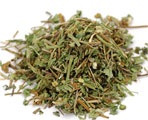



Gotu kola has been widely used to treat a variety of illnesses, particularly in traditional Eastern medicine. Sri Lankans noticed that elephants, renowned for their longevity, munched on the leaves of the plant. Thus the leaves became known as a promoter of long life, with a suggested "dosage" of a few leaves each day. Among the ailments purported to be cured or controlled by gotu kola are mental problems, high blood pressure, abscesses, rheumatism, fever, ulcers, leprosy, skin erup?tions, nervous disorders and jaundice. Gotu kola has been touted as an aphrodisiac. Gotu kola should not be confused with the dried seed of Cola nitide (Vent.) (also known as kolanuts, kola or cola), the plant used in cola beverages. Cola nitida contains caffeine and is a stimu?lant, while gotu kola has no caffeine and has sedative properties.
Extracts of gotu kola contain the active principle madecassol, as well as asiatic acid and the glycoside asiaticoside.2 Also present is isothankuniside. This compound has been used to derive another sub?stance called BK compound (methyl 5-hydroxy-3,6-di?oxo-23 (or 24)-nor-urs-12-ene-28-oate).3 Below-ground parts of C. asiatica have been found to contain small amounts of at least 14 different polyacetylenes. The molecular structures of five of these have been deter?mined: 2,9-pentadecadiene-4,6-diyn-1-o1, acetate; (2) pentadeca-1,9-diene-4,6-diyne-3,8-diol, 8-monoac?etate; (3) pentadeca-1 ,9-diene-4,6-diyne-3,8 diol, diace? tate; pentadeca-1 ,8-diene-4,6-diyne-3, 1 O-diol, 10-monoacetate and (5) pentadeca (1,8)-diene?4,6-diyne-3,10-diol. Nine other polyacetylenes have been partially characterized.
A recent phytochemical of C. asiatica revealed the pres?ence of amino acids, flavonols, fatty acids, alkaloids, sterols, saccharides and inorganic salts. The bio-stimu?lant activity is attributed to asiaticoside, asiatic acid and madecassic acid.5 A study of powdered gotu kola by microscopic and chemical identification methods has also recently been done.
Wound healing: C. asiatica extracts have beenfou promote wound healing? Cell culture experiments shown that the total triterpenoid fraction of the extracls, a concentration of 25 mcg/ml does not affect cell pI( eration, total cell protein synthesis or the biosynthesil proteoglycans in human skin fibroblasts. However,l fraction does significantly increase the collagen conten cell layer fibronectin, which may explain the action wound healing.8 The glycoside madecassoside has a inflammatory properties, while asiaticoside appears stimulate wound healing. Experiments with rats shfti that wounds heal by a process involving a dilation p followed by a contraction phase. These phases w prolonged in rats undergoing repeated expenme wounding. Titrated extract of C. asiatica (TECA, mg/kg), however, accelerated healing time? A . employing rats and mice found that topically appTECA rapidly penetrated to subcutaneous tissues a abdominal muscle in high concentrations, and hao greater effect on wound healing than oral administrai Asiatic acid was absorbed later than madecassic aj The topical preparations of TECA were also able penetrate to the plasma and deeper tissues.
Other Topical Uses: TECA has been used as a agent to stimulate wound healing in patients with chr lesions such as cutaneous ulcers, surgical wounds, fi las and gynecologic lesions. A clinical study evalua TECA for treating bladder lesions in 102 patients biharzial infections. Injections of TECA 2%, usually ministered intramuscularly, for 1 to 3 months, produ cure or improvement in 75% of the cases, as determi from symptoms, urinary findings and cystoscopic fings. Healing occurred with little scar formation, tl avoiding much of the loss of bladder capacity that result from biharzial infections.
C. asiatica has also shown promise in treatmen!i psoriasis. When creams containing oil and water extra! of the leaves were administered each morning to sev psoriatic patients, five showed complete clearance lesions within 3 to 7 weeks. One patient showed cI8 ance of most lesions, and one showed improvemi without clearance. One patient experienced a mildrec rence 4 months after treatment. Although this study not controlled, a placebo effect was considered unll.
Copyright © Krishna Herbal Company 2022. All Rights Reserved Powered By: Planet Ayurveda







